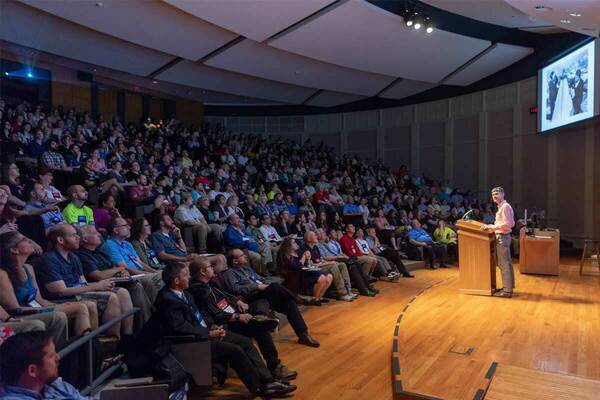
In July, 1,700 college, high school, and middle school chemistry educators from across the country attended the American Chemical Society’s 25th Biennial Conference on Chemical Education (BCCE) hosted for the first time at Notre Dame.

“This was the largest BCCE overall, and it was the largest academic conference ever held at Notre Dame,” said Steven Wietstock, conference program chair and associate teaching professor/teaching lab safety coordinator in the Department of Chemistry and Biochemistry at Notre Dame.
Participants presented nearly 1,400 papers and 125 workshops. Topics centered around chemical education research, including information on how students learn and how to apply that to teaching.
The BCCE also featured four plenary sessions with speakers who are renowned in their field. Marcy H. Towns, a professor of chemistry and the director of general chemistry at Purdue University kicked off the event. A long-time chemical educator, Towns received both the ACS Award for Achievement in Research for the Teaching and Learning of Chemistry and the most prestigious award the ACS offers for excellence in teaching.
“This conference represented 50 years of chemical education,” said Wietstock. “We wanted to look back and into the future of our field. Marcy Towns has a long history in the field and the ACS.”
The five-day conference provided teachers the opportunities to network, share and gather new ideas, and learn about what their colleagues are doing in the classroom. Participants presented nearly 1,400 papers and 125 workshops. Topics centered around chemical education research, including information on how students learn and how to apply that to teaching, explained Wietstock.
Penny Snetsinger, who teaches introductory and advanced chemistry at Sacred Heart University in Fairfield, Connecticut, has been attending the conference for 27 years. “I get a lot of great ideas from the symposiums for engaging my students in active learning the classroom,” she said. “I’m the only physical chemist at my college, so I really enjoy talking to other colleagues, too”
Monday morning, participants heard Notre Dame faculty Jennifer Tank, professor of biology; Marya Lieberman, professor of chemistry and biochemistry; Ryan Roeder, professor of aerospace and mechanical engineering; and Paul Bohn, professor of chemical and biomolecular engineering, share how their scientific research impacts communities across the globe.
Conference speaker Dr. Jacob Clark Blickenstaff, a passionate advocate for overcoming socio-economic, ethnic and gender barriers in teaching science to help all students have access to high quality science education, addressed the group on Tuesday morning about challenging binary thinking in education. Dr. Blickenstaff has an unconventional role in promoting science education equity – as a movie critic in “Blick on Flicks,” a regular column in NSTA Reports.
Popular science writer and author Sam Kean, the author of four books, including The Disappearing Spoon, entertained and delighted the crowd with fascinating tales about some of the elements on the periodic table. “Stories always stuck with me,” said Kean. “The periodic table is one of the richest sources of stories out there.”
Denver high school chemistry educator Amy Hanson was thrilled to have the opportunity to hear Kean speak after reading his book The Disappearing Spoon. And as a teacher of introductory chemistry and advanced placement (AP) chemistry, she appreciated the mix of high school and college faculty at the conference. “I like all the new ideas I learn about at the conference,” she explained. “And I also like talking to college educators about what they are teaching students in their classrooms, because that’s where my AP students will be headed soon.”
The planning committee provided opportunities for fun and relaxation, too. In addition to a golf outing and a food truck extravaganza, “Al D. Hyde and the Key Notes,” a band formed by chemical educators, entertained conference participants with their high-energy performance.
Over the years, non-tenure track teaching faculty have become more mainstream in top-flight institutions like Notre Dame, Wietstock explained. “We are all chemical educators who work in the classroom, and we are not doing research,” he said. “This conference is a great opportunity to get to know others doing the same thing and showcase our innovative teaching methods and learn from our colleagues at other institutions.”
Conference participants were drawn to Notre Dame’s central location and its beautiful campus, said Wietstock. “It was also a chance for Notre Dame to show that the University has the capability to and the facilities to host very large academic conferences in the future.”
Originally published by at science.nd.edu on August 29, 2018.